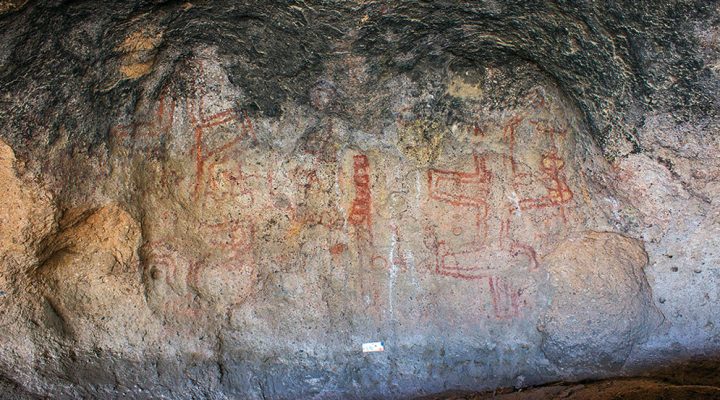- News / CONICET scientists dated the oldest cave paintings in South America
SOCIAL SCIENCES AND THE HUMANITIES
CONICET scientists dated the oldest cave paintings in South America
A multidisciplinary team directly dated a series of four images that were found in Cueva Huenul (Neuquén) and revealed human resilience strategies in the face of hostile environmental changes. The oldest is 8,200 years old.
The Huenul Cave (located in the province of Neuquén) archives information about the past: remains of extinct animals, vegetation, pigments and decorated artifacts that reveal different forms of human occupation for thousands of years. These vestiges make up small pieces that allowed these experts to progressively put together a large puzzle that took them thirteen years to solve . In particular, the images painted on the walls provided unprecedented information about the occupation of the cave by the region’s hunter-gatherer populations during a challenging climatic period, approximately 8,200 years ago. These are the oldest cave paintings in South America dated to date. The study was published in the journal Science Advances.
There was a period of extreme aridity in Patagonia and in all the areas that cover the deserts of South America 8,200 years ago. It significantly impacted the availability of some key resources for groups of hunter-gatherers in the region, such as water, vegetation and fauna. Is there a relationship, beyond the spatial and temporal coincidence, between this climatic phenomenon and the appearance of paintings from the Huenul Cave? That was the question the researchers asked themselves and that guided the project.
“We think that rock art played a key role in the construction of human resilience in this context of climate change during the middle Holocene, due to its capacity to not only accumulate traditional indigenous knowledge linked to the maintenance of collective knowledge and memories about life in the desert, but also because this information can be preserved over time and transmitted to future generations,” explains Guadalupe Romero Villanueva, CONICET postdoctoral fellow at the Instituto Nacional de Antropología y Pensamiento Latinoamericano (INAPL) and first author of the work.
The oldest of the four paintings found in Cueva Huenul is 8,200 years old, while the closest to the present was painted 5 thousand years ago. This distance of 3 million years between one image and another, taking into account that the paintings illustrate the same motif (they are all shaped like a comb) with almost no visual variants and with the same techniques, indicates the intention of maintaining in time, generation after generation, this particular painting practice.
“It is very complex to directly date rock art from a technical and methodological point of view. To be able to date the painting with the carbon 14 method, the painting must have been made with organic material. Furthermore, in general, when we find these types of early records, they are also the ones that were most exposed to environmental degradation over time. The motifs had been made with charcoal and the state of conservation of the samples was adequate to subject them to dating because during this period the degree of occupation of the cave was virtually zero and no additional carbon product accumulated on the walls where the paintings were. The ideal conditions were combined to date them,” says the researcher.
In addition to the paintings, the scientists found a bundle of ocher-stained branches, which is the only evidence found in the cave sediment assignable to the middle Holocene. This finding, together with the dated rock motifs, reaffirm the hypothesis that the site was important for the visual communication of the human populations that inhabited the area.
“At that time there was evidently an intention to mark the place with images and colors. Color and image are elements that convey the communication of information on multiple spatial and temporal scales. We believe that we sought to equip the cave and the landscape that surrounds it with ecological and social information that could last over time and be useful for future generations. This strategy could have been very valuable for human groups that moved all the time from one place to another or were not in frequent contact with each other,” says Romero Villanueva.
Ramiro Barberena, independent CONICET researcher at the Instituto Interdisciplinario de Ciencias Básicas (ICB, CONICET) and leader of the Cueva Huenul project, highlights the multidisciplinary nature of the research. Combining climatic, demographic and archaeological information allowed the paintings to be put into context.
“We used a database that had already been published of all the radiocarbon dates for human occupation in the deserts of South America, to be able to estimate how many people there were in these places over time. This period is characterized by demographic stagnation. It is inferred that in northern Patagonia there was a population that was having a hard time growing,” he explains.
The cave paintings found, as interpreted by researchers, reflect survival strategies against hostile natural conditions.
“In this film, an ecological scenario of high aridity is combined; a demographic scenario of few people distributed in very low density, and a population with the capacity for resilience. This use of rock art to transmit information allows us to infer that Cueva Huenul was a node of trans-generational human interaction and communication: a meeting point between populations despite everything,” concludes Barberena.
A reservoir of the history of Patagonian human populations
A bill was recently presented in the Neuquén legislature to declare Cueva Huenul as Cultural, Archaeological and Paleontological Heritage. “We intend to implement a management plan and public use of the site and its surroundings, with the aim of actively contributing to its conservation so that Cueva Huenul continues to be a place where successive generations of humans can meet, communicate and, Above all, learn from our past experiences,” says Romero Villanueva.
References
By Alejandro Cannizzaro
